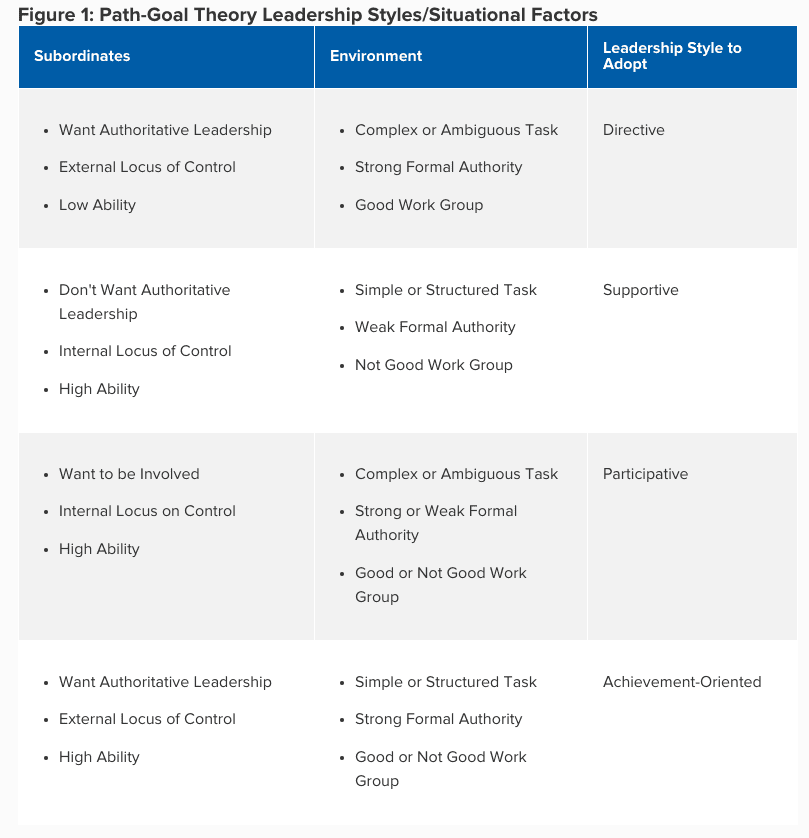How to Choose the Right Leadership Styles For Your Team
This post is a bit out-of-date, and we have a better one on the Three Main Management Types and their pros and cons. You can read this post (or both!) but you’ll be better served by our most recent piece.
As a team leader, you probably noticed that it’s not easy always to choose the right leadership styles. For example, encouraging your team to participate in decision-making and overachieve are great ways to keep them motivated and effective. However there may be a couple people in your team who just can’t seem to catch up to the rest. Why could that be, and what can you do to help them perform and stay happy in their roles?
A leadership theory developed by psychologist Robert House may be your answer. His Path-Goal Theory shows how to help your team members on their paths to achieve their goals, and get their desired rewards. Robert House encourages leaders to adapt their leadership styles to each employee’s unique needs, as well as their current work situation. He suggests being flexible in your approach rather than going with the “one size fits all” strategy, and adjusting your style as the person’s needs and experience progresses.
By giving each employee unique combinations of support, info, and other resources they need, you’ll remove obstacles on their path to their goals.
Ready to try it out? Here are the deets.
The 4 Types of Leadership Styles and When to Use Them
Supportive Leadership
This approach entails giving your team member support and care to help them handle the stress or frustration that come with their jobs. Basically, you would help remove or reduce any emotional obstacles on their path to their goal and create a supportive work environment. Robert House explained that when under stress, people have a hard time applying their intelligence and rely more on experience. This can cause performance issues. A supportive leader helps teammates improve their performance, and compensates for any unpleasant aspects of the work.
- When to use it:
- It can be helpful for a team that is new, inexperienced, or otherwise lacks confidence.
- The employee is stressed.
- The work is simple/repetitive and is not something the person finds interesting or intrinsically motivating.
- It works best when the employee likes to be in charge of decision-making and in control of her own tasks, and doesn’t want close supervision.
- How to use it:
- Consider implementing weekly check ins. Ask how the team member is doing, what they are struggling with, and what you can do to help.
- Show empathy and sensitivity. Sympathize with the frustrating aspects of the work.
- Remind them why their tasks are valuable to the team, and how important they are to the organization as a whole.
- Reinforce performance with praise and other available rewards.
Directive Leadership
This leadership style is about giving clear direction and guidance. With this approach, the leader clarifies exactly how to do the job. This style of leadership helps team members cope with otherwise vague and unclear job responsibilities.
- When to use it:
- The team member has difficulty doing tasks or lacks experience.
- It works best for individuals who prefer dependence and direction from others.
- Note: this approach is not helpful for people who are already highly motivated, and have the experience to do the work without someone’s interference. If you spend time explaining tasks to individuals who know what they’re doing, they will likely find it redundant or even insulting.
- How to use it:
- Meet with the team one on one at the start of the project, to clarify exactly what needs to be done and the required outcomes and performance standards.
- Assign specific tasks, schedule their timeline, and coordinate their work.
- Demonstrate how to do the work, step-by-step.
- Provide them with written instructions or a cheat sheet with the outlines steps and how to do them.
- Meet regularly to ask them where they need help, provide more guidance, and clarify any steps of the process.
Participative Leadership
With this approach, the leader encourages her team to participate in decision making and problem-solving. She consult’s her team’s ideas and accepts their input before making decisions, and relies on their collective feedback and knowledge. Team members tend to be highly encouraged and motivated by this style of leadership. Having more influence and autonomy leads to higher performance and effort, and makes them more committed to the organization.
- When to use it:
- The team member is skilled at what they do
- The work requires creativity and innovative ideas
- It works best for people who prefer independence and self direction, and who want to be involved.
- It’s best-used in companies where team building is important, and where quality of decision-making is valued more than speed.
- How to use it:
- Ask for your team’s input before sending off a deliverable or making a decision. Start and facilitate conversations about specific decisions.
- Delegate areas of responsibilities among your team members. Assign them to independently solve problems within their area of responsibility. You may decide to have them run the final version of their solutions by you, or to ship independently.
- Share more information and power with your team members. Invest in training your team to empower them to make decisions
- Encourage collective and private idea collaboration. Hold regular brainstorming sessions or meetings to discuss issues.
- Communicate final decisions to your team.
Achievement-Oriented Leadership
This leadership style is based on encouraging your teammates to achieve personally outstanding results. Here you set challenging goals, and express confidence in their ability to achieve them. This approach motivates your teammates because it gives them confidence in their own ability to excel.
- When to use it:
- The team member is skilled in what they do, and is not stressed from work overload.
- It works best for people who like challenges, are highly motivated, and enjoy making accomplishments through their own efforts rather than relying on delegating tasks to others.
- How to use it:
- Meet one on one with each team member to discuss which results you would like them to demonstrate, and express confidence in their ability to achieve them.
- Agree on objectives and performance standards together. Encourage them to set higher objectives, but listen to which performance standards they feel are realistic to achieve. Agree on an action plan.
- Take some time to chat about areas that need improvement and set a few developmental goals. Agree on a timeframe to complete and review these goals. Ask the employee how she thinks she can do better, and how she can avoid problems faced in the past.
- Give continuous feedback, reinforce performance with praise or other agreed-upon rewards, and provide resources such as training, tools, or readings.
Choose Carefully
The key thing to remember is that you may need to lead each employee with different leadership styles as they progress throughout the project. For example, if you are working on a project with someone from a different department, who is confused about what you need them to do, providing clear instructions and direction is a good way to start. As they become more skilled and enjoy the challenges of the work, they’ll perform better under an achievement-oriented style.
If a team member is currently working on a repetitive or otherwise boring portion of his project, they may need your support, praise, and sympathy. As they finish those deliverables and progress onto tasks that require creativity and individual buy-in to decisions, shift towards the participative approach.
House explained that any of these leadership styles will only be effective if you clarify the team member’s performance goals, performance standards, your expectations from them, and give regular positive and negative feedback.
For the approaches to be successful you would also need to understand your team members’ needs and the natures of their work. This can be tough to do, so Mind Tools created a useful chart that summarizes how to choose a leadership approach.

*Note that this chart mentions locus of control. Those with an internal locus of control like to be in charge of the events in their life. Those with an external locus of control, tend to believe that external factors control outcomes more than their own actions.
Have questions about one of these four leadership styles? Tweet us @unitoio!


